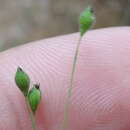Comprehensive Description
provided by North American Flora
Panicum brachyanthum Steud. Syn. Gram. 67. 1854
Panicum sparsijlorum Vasey, Bull. U. S. Dep. Agr. Bot. 8: 36. 1889. Not P. sparsifiorum Doell, 1877.
Plants weakly ascending or spreading from a decumbent base, freely branching from the lower nodes; culms slender, 30-100 cm. high; leaf-sheaths shorter than the internodes, minutely ciliate; blades 5-15 cm. long, 2-3 mm. wide, narrowed toward the base, often involute and scabrous toward the apex, the uppermost usually reduced; panicles finally exserted, 5-15 cm. long, about as wide, the branches few, scabrous, the lower sometimes as much as 10 cm. long, bearing a few short-pediceled spikelets, mostly in twos, toward the ends; spikelets 3.2-3.6 mm. long, 1.5 mm. wide, elliptic-obovate, abruptly pointed; first glume minute; second glume and sterile lemma subequal, the tubercles bearing stiff, spreading hairs; fruit 2.9-3 mm. long, 1.4 mm. wide, obovate-elliptic, subacute.
Type locality: Texas.
Distribution: Louisiana, Oklahoma, and Texas.
- bibliographic citation
- George Valentine Nash. 1915. (POALES); POACEAE (pars). North American flora. vol 17(3). New York Botanical Garden, New York, NY
Physical Description
provided by USDA PLANTS text
Annuals, Terrestrial, not aquatic, Stems trailing, spreading or prostrate, Stems nodes swollen or brittle, Stems erect or ascending, Stems geniculate, decumbent, or lax, sometimes rooting at nodes, Stems caespitose, tufted, or clustered, Stems terete, round in cross section, or polygonal, Stems branching above base or distally at nodes, Stem internodes hollow, Stems with inflorescence less than 1 m tall, Stems, culms, or scapes exceeding basal leaves, Leaves mostly cauline, Leaves conspicuously 2-ranked, distichous, Leaves sheathing at base, Leaf sheath mostly open, or loose, Leaf sheath smooth, glabrous, Leaf sheath and blade differentiated, Leaf blades linear, Leaf blades very narrow or filiform, less than 2 mm wide, Leaf blades 2-10 mm wide, Leaf blades mostly flat, Leaf blade margins folded, involute, or conduplicate, Leaf blades mostly glabrous, Leaf blades more or less hairy, Leaf blades scabrous, roughened, or wrinkled, Ligule present, Ligule a fringe of hairs, Inflorescence terminal, Inflorescence an open panicle, openly paniculate, branches spreading, Inflorescence solitary, with 1 spike, fascicle, glomerule, head, or cluster per stem or culm, Inflorescence with 2-10 branches, Flowers bisexual, Spikelets pedicellate, Spikelets dorsally co mpressed or terete, Spikelet less than 3 mm wide, Spikelets with 1 fertile floret, Spikelets with 2 florets, Spikelet with 1 fertile floret and 1-2 sterile florets, Spikelets solitary at rachis nodes, Spikelets all alike and fertille, Spikelets bisexual, Spikelets disarticulating below the glumes, Rachilla or pedicel glabrous, Glumes present, empty bracts, Glumes 2 clearly present, Glumes distinctly unequal, Glumes equal to or longer than adjacent lemma, Glume equal to or longer than spikelet, Glumes and spikelets tuberculate, warty, or spiny, Glumes 1 nerved, Glumes 4-7 nerved, Lemma similar in texture to glumes, Lemma 5-7 nerved, Lemma glabrous, Lemma apex acute or acuminate, Lemma awnless, Lemma margins inrolled, tightly covering palea and caryopsis, Lemma straight, Palea present, well developed, Palea about equal to lemma, Stamens 3, Styles 2-fid, deeply 2-branched, Stigmas 2, Fruit - caryopsis, Caryopsis ellipsoid, longitudinally grooved, hilum long-linear.

